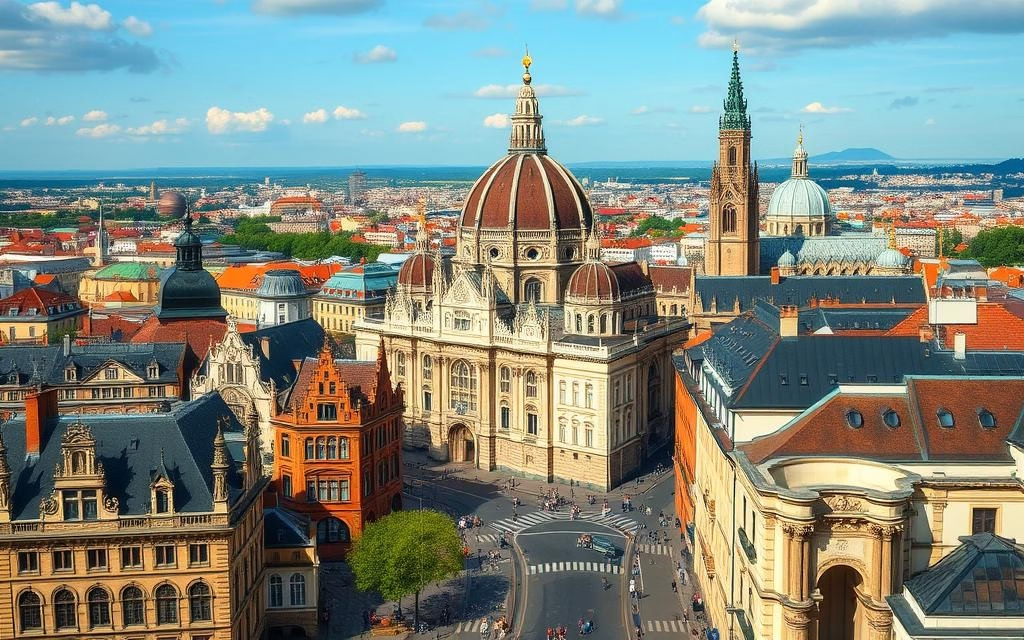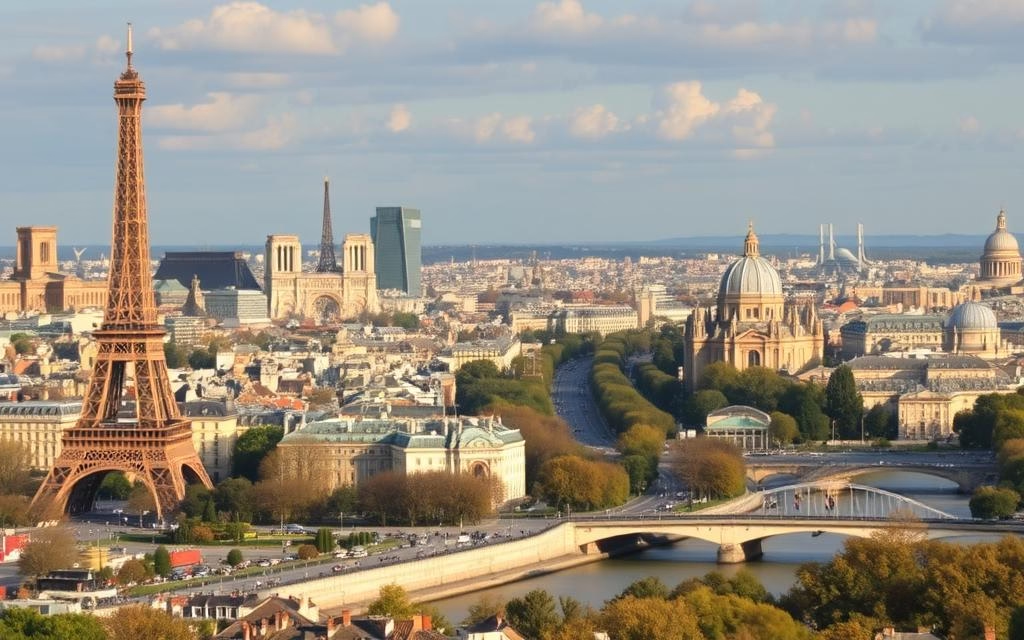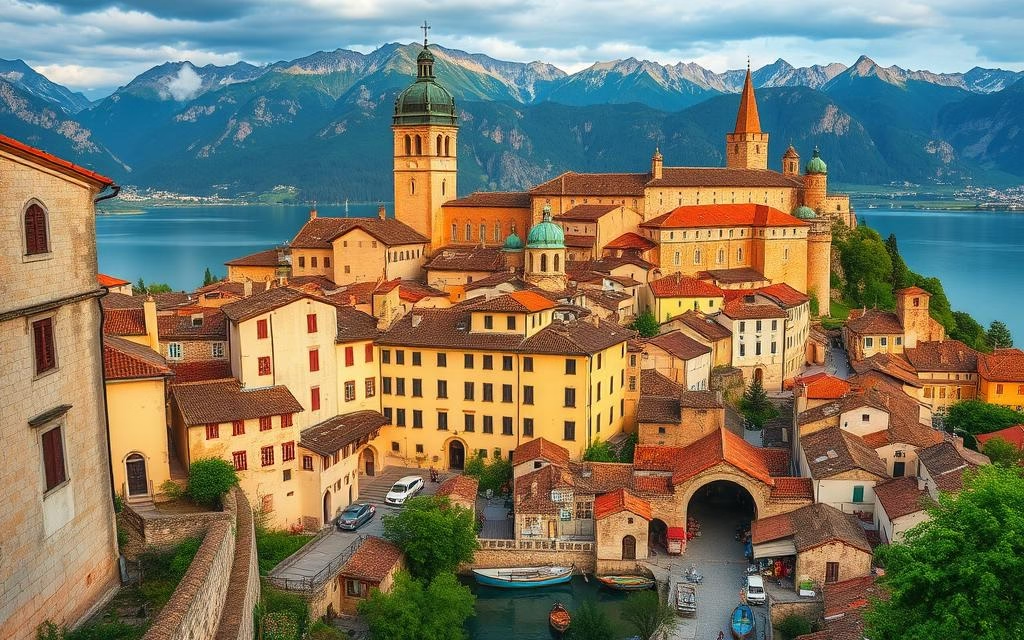Explore Europe’s Top Cultural Landmarks Europe boasts a wide range of cultural landmarks, each with its own story. Famous spots like the Eiffel Tower and Big Ben are just the beginning. Historical sites such as the Colosseum and Acropolis also await. The Eiffel Tower, a symbol of Europe, welcomes millions annually.
These landmarks showcase Europe’s rich cultural past. They attract visitors from all over. Whether you’re into history, culture, or just want to see the beauty of Europe, there’s plenty to discover.
Key Takeaways
- Europe is home to a diverse array of cultural landmarks in europe, each with its own unique history and significance.
- Famous landmarks in europe like the Eiffel Tower and Big Ben are must-visit destinations for any traveler.
- Historical sites europe like the Colosseum and Acropolis offer a glimpse into the continent’s rich cultural heritage.
- Cultural landmarks in europe are a major draw for tourists, with many visitors flocking to see famous landmarks in europe each year.
- Exploring historical sites europe is a great way to learn about the continent’s history and culture.
- From the Eiffel Tower to the Acropolis, there’s no shortage of iconic cultural landmarks in europe to explore.
Introduction to Europe’s Cultural Landmarks
Europe is filled with iconic attractions that show off its rich culture. Places like the Palace of Versailles and the Louvre are full of art and history. They tell the story of Europe’s past and its architectural growth.
Landmarks like the Eiffel Tower, the Colosseum, and Big Ben have their own stories. They are big draws for tourists, with millions visiting each year.
The Importance of Cultural Heritage
Cultural heritage is key to understanding Europe’s history and identity. Keeping these landmarks safe is vital. They let us peek into the past and see how people lived before.
By visiting these spots, tourists can really appreciate Europe’s culture and history.
Overview of Landmarks Across Different Countries
Europe’s cultural landmarks are spread across many countries. Each has its own history and charm. Some of the best include:
- The Acropolis in Greece
- The Louvre in France
- The Colosseum in Italy
- Big Ben in the UK
These spots are a must-see for anyone who loves history, culture, and architecture.
Exploring Europe’s cultural landmarks lets tourists dive into the continent’s rich history and culture. Whether you’re into art, architecture, or history, there’s something for everyone.
Iconic Landmarks in Western Europe
Western Europe is filled with european heritage sites, showing the area’s deep history and culture. Famous spots like the Eiffel Tower, the Colosseum, and Big Ben draw millions yearly.
These historic sites are known for their stunning architecture and historical value. The Eiffel Tower was built for the 1889 World’s Fair. The Colosseum dates back to the 1st century AD.
Some key european heritage sites in Western Europe include:
- The Eiffel Tower in Paris, France
- The Colosseum in Rome, Italy
- Big Ben in London, United Kingdom
Visitors to these landmarks can dive into the region’s culture and history. With over 171 World Heritage Sites in Western Europe, there’s much to see.
| Landmark | Location | Year Built |
|---|---|---|
| Eiffel Tower | Paris, France | 1889 |
| Colosseum | Rome, Italy | 1st century AD |
| Big Ben | London, United Kingdom | 1859 |
Stunning Structures in Eastern Europe
Eastern Europe boasts a wealth of cultural landmarks in europe. Each has its own story and design. From Russia’s grand palaces to the Czech Republic’s historic castles, there’s much to see.
Some top historical sites in europe include the Kremlin in Moscow, Prague Castle in the Czech Republic, and Budapest’s Chain Bridge. These spots show the area’s deep cultural roots. They’re key for anyone into history and architecture.
Here are a few examples of Eastern Europe’s stunning structures:
- The Kremlin: A grand palace in Moscow that has been the seat of Russian power for centuries.
- Prague Castle: A historic castle complex in the Czech Republic that is recognized as one of the largest in the world.
- The Chain Bridge: An iconic bridge in Budapest that connects the city’s two halves and offers stunning views of the Danube River.
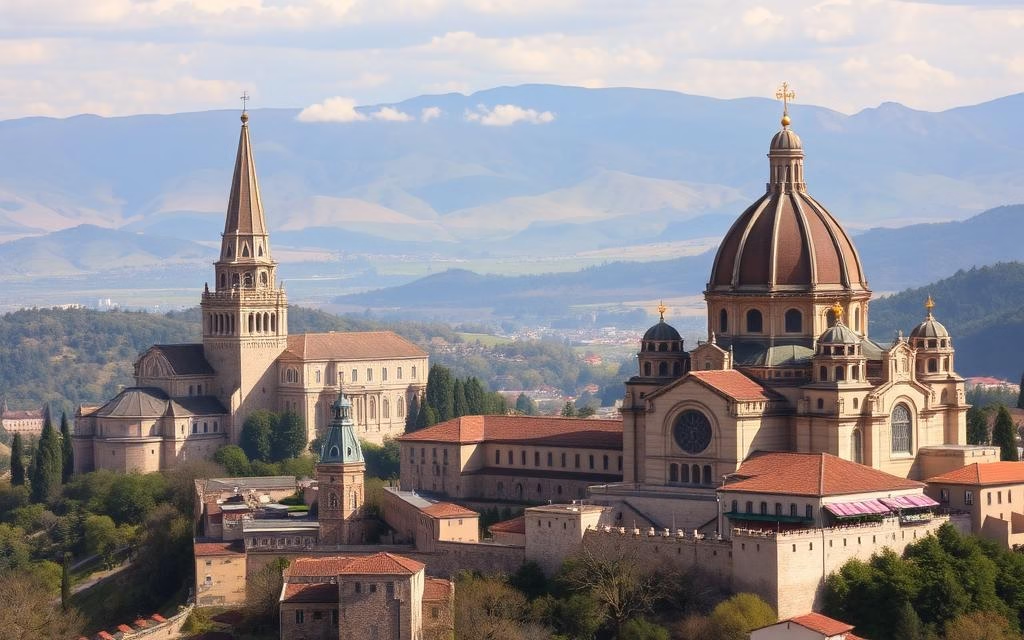
| Landmark | Location | Description |
|---|---|---|
| The Kremlin | Moscow, Russia | A grand palace that has been the seat of Russian power for centuries. |
| Prague Castle | Prague, Czech Republic | A historic castle complex that is recognized as one of the largest in the world. |
| The Chain Bridge | Budapest, Hungary | An iconic bridge that connects the city’s two halves and offers stunning views of the Danube River. |
Architectural Marvels in Southern Europe
Explore Europe’s Top Cultural Landmarks Europe boasts some of the world’s most breathtaking architectural wonders. The Alhambra, the Leaning Tower of Pisa, and the Acropolis are just a few examples. These iconic attractions Europe highlight the area’s rich cultural heritage. Each landmark showcases the unique architectural styles and historical importance of the region.
Some of the must-see European landmarks in Southern Europe include:
- The Alhambra in Spain, a UNESCO World Heritage Site and a masterpiece of Moorish architecture
- The Leaning Tower of Pisa in Italy, one of the most recognizable landmarks in the world
- The Acropolis in Greece, a ancient citadel and home to the Parthenon, one of the most significant ancient buildings
These top cultural landmarks Europe are not just historical gems but also major tourist draws. They attract millions of visitors annually. The best time to visit is in spring and autumn, when the weather is nice and prices are lower than in summer.
Visitors to Southern Europe can explore a unique mix of history, culture, and architecture. It’s a must-see for anyone interested in iconic attractions Europe and must-see European landmarks.
| Landmark | Location | Architectural Style |
|---|---|---|
| Alhambra | Spain | Moorish |
| Leaning Tower of Pisa | Italy | Romanesque |
| Acropolis | Greece | Ancient Greek |
Northern Europe’s Unique Cultural Sites
Northern Europe boasts a wealth of unique cultural sites. These sites show the region’s rich european heritage sites. The Little Mermaid in Copenhagen and the Vasa Museum in Sweden are just a few examples. Each one highlights the area’s unique architectural styles and historical importance.
Many of these sites are recognized as UNESCO World Heritage Sites. This makes Northern Europe a treasure trove for history buffs and culture enthusiasts.
Some of the most famous popular landmarks in europe are in Northern Europe. The Sagrada Familia in Barcelona is a standout, thanks to Antoni Gaudí’s design. The Gamla Stan in Stockholm and the Helsinki Cathedral in Finland are also must-sees. They offer a glimpse into the region’s european heritage sites.
The region’s cultural sites go beyond landmarks. The Vigeland Sculpture Park in Oslo, with over 650 sculptures, is a unique attraction. The Royal Palace in Stockholm, with its 600+ rooms, showcases the area’s cultural wealth.
Some key cultural sites in Northern Europe include:
- The Little Mermaid in Copenhagen
- The Vasa Museum in Sweden
- The Sagrada Familia in Barcelona
- The Gamla Stan in Stockholm
- The Helsinki Cathedral in Finland
These sites are just a few of the many popular landmarks in europe in Northern Europe. They are essential for anyone wanting to delve into the region’s rich cultural heritage.
UNESCO World Heritage Sites in Europe
Europe boasts a wide range of cultural landmarks. These include famous landmarks and historical sites recognized by UNESCO. The Palace of Versailles and the Acropolis are just two examples of these notable sites.
To be recognized by UNESCO, sites must have unique cultural or natural value. The Palace of Versailles, the Acropolis, and the Colosseum are among the most notable UNESCO sites in Europe. They showcase the continent’s rich cultural heritage.
These historical sites attract millions of visitors each year. The Palace of Versailles is one of the most visited tourist spots in the world. It highlights the importance of cultural landmarks in Europe.
Other notable UNESCO World Heritage Sites in Europe include Pompeii, Florence, and Carcassonne. These sites are famous landmarks and historical sites preserved for their cultural and historical significance.
Museums That Showcase Cultural Heritage
Europe is filled with famous museums that highlight its rich cultural heritage. The Louvre in Paris is a top spot, known for its art and artifacts. The British Museum in London is another gem, showing the world’s history and the British Empire’s impact.
Some of Europe’s most famous museums include:
- The Louvre: featuring an extensive collection of art and artifacts, including the Mona Lisa
- The British Museum: home to a vast collection of artifacts from around the world, including the Rosetta Stone and Egyptian mummies
- The Vatican Museums: showcasing a stunning collection of art and artifacts, including works by Michelangelo and Raphael, and a must-see european landmarks
These museums are key cultural spots and draw millions each year. They offer a peek into history, showing Europe’s art, culture, and more. They are among the top cultural landmarks in Europe.
Visiting these museums helps you understand Europe’s cultural heritage. They are essential for anyone exploring Europe’s iconic attractions and must-see landmarks.
| Museum | Location | Notable Collections |
|---|---|---|
| The Louvre | Paris | Art and artifacts from ancient civilizations to the 19th century |
| The British Museum | London | Artifacts from around the world, including the Rosetta Stone and Egyptian mummies |
| The Vatican Museums | Vatican City | Art and artifacts from the Vatican, including works by Michelangelo and Raphael |
Religious Landmarks of Europe
Europe is filled with european heritage sites, each showing the continent’s deep cultural and spiritual roots. Famous landmarks like St. Peter’s Basilica, the biggest Christian church, and the Cathedral of Notre Dame, a famous Gothic cathedral, stand out. These places are not just beautiful but also hold great spiritual and historical value.
The Duomo in Milan is another example, a grand cathedral that highlights Italian architectural brilliance. Visitors get to see the mix of art, history, and spirituality that makes Europe’s culture so unique.
- St. Peter’s Basilica in Vatican City
- The Cathedral of Notre Dame in Paris
- The Duomo in Milan
These sites draw millions of visitors yearly. They come to admire their beauty, learn about their past, and feel the spiritual depth of these european heritage sites.
The Influence of European Cultural Festivals
European cultural festivals greatly impact the continent’s culture. They showcase cultural landmarks in europe and famous landmarks in europe. These events promote local traditions and art, boosting the economy and social bonds.
Notable festivals include the Cannes Film Festival, La Tomatina, and the Edinburgh Festival Fringe. They draw millions, helping local economies and highlighting historical sites europe.
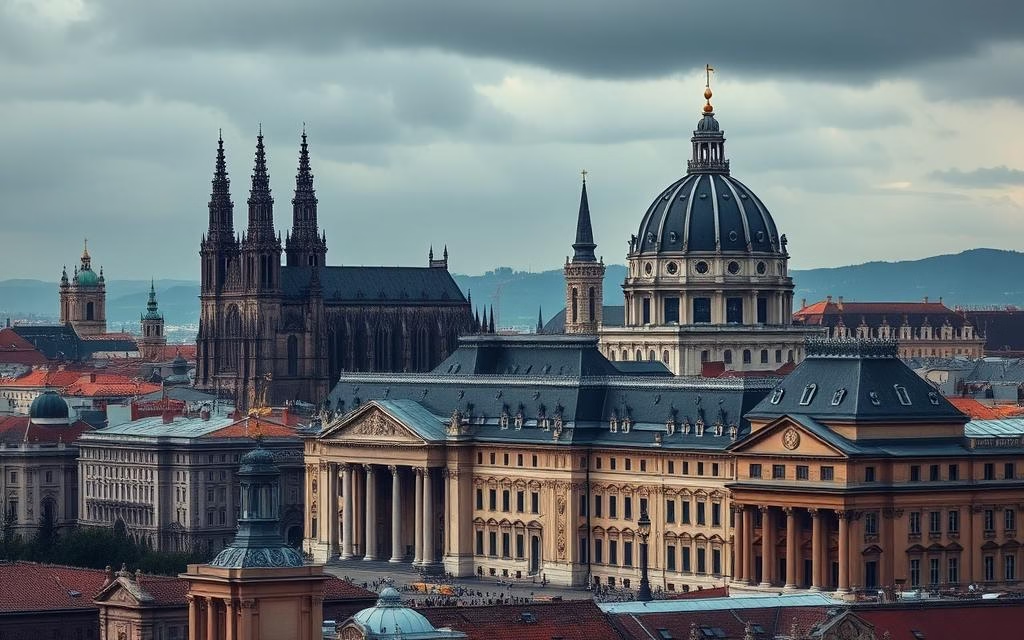
The European Festival Association says over 100 major festivals attract 10 million visitors yearly. About 40% of Europeans visit at least one festival annually. This shows how vital festivals are for cultural landmarks in europe and famous landmarks in europe.
Cultural festivals also foster social unity and community spirit. A Eurobarometer survey found 47% of Europeans believe cultural activities improve social bonds. This makes historical sites europe a key part of the continent’s heritage.
How to Experience These Landmarks
Exploring iconic attractions europe is an exciting adventure. But, it’s important to plan well to enjoy your trip fully. With so many must-see european landmarks, it’s key to make a good plan.
For the best experience, visit in spring or autumn. The weather is nice, and there are fewer people. This way, you can really take in the beauty and importance of these places.
- Research the best times to visit each landmark to avoid crowds
- Plan your itinerary in advance to ensure you have enough time to explore each site
- Take advantage of public transportation in European cities to get around easily
| Landmark | Best Time to Visit | Transportation Options |
|---|---|---|
| Eiffel Tower | Spring and Autumn | Metro, Bus |
| Colosseum | Early Morning or Late Evening | Metro, Walking |
Conclusion: Embracing Europe’s Cultural Heritage
Europe’s cultural heritage is a treasure that must be kept safe for future generations. It includes famous European heritage sites and popular landmarks in Europe. Also, the lively best historic sites Europe show the continent’s lasting spirit.
The Importance of Preservation
Keeping this heritage safe is more than just protecting buildings and items. It’s about keeping alive the stories, traditions, and values that make Europe unique. By saving these European heritage sites, we help visitors learn and appreciate Europe’s history.
Encouraging Responsible Tourism
With more international arrivals in Europe, it’s key to support responsible tourism. This means helping local communities and protecting the environment. It also means giving visitors real, meaningful experiences that connect them to Europe’s heritage.

